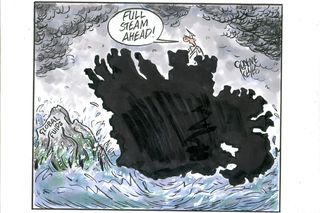Scandal of 3,600 council homes now lying empty
Scandal of house left empty for two years by council

A three-bed house just a short distance from the hotel where a homeless mother took her own life has been lying empty for more than two years after being sold to the local council.
The furnished, three-bed detached bungalow is located off Main Street in Leixlip.
It was sold to Kildare County Council with a €300,000 price tag in July 2016, but has yet to be filled by any tenants.
It comes in the teeth of the housing crisis, when millions of euro are being spent on emergency hotel accommodation - including at the nearby Leixlip House Hotel, less than a kilometre away.
Tragically, in September 2017, mum-of-two Danielle Carroll (27) took her own life while living at the hotel with her two young boys aged seven and 20 months.
The young woman from Tallaght had previously been allocated a house with South Dublin County Council, but it was later withdrawn.
Today, children's clothes can be seen hanging inside the windows of the hotel, which continues to provide accommodation for homeless families.
The former owner of the nearby house is perplexed at why the ideal family home is not being put to good use.
Brian McTernan said he sold the property to the council "furnished down to the kitchen utensils".
"There was a three-piece suite, a table and chairs in the kitchen, there was two beds and everything in the kitchen regards pots and pans," he said. "I have been approached with inquiries from what could have been 25 people at this stage. They know I sold it and they know it's empty."
Mr McTernan, who first voiced his concerns on the RTÉ Radio 1 Liveline programme, said he feared the property had now gone into disrepair.
"You can see the house is shabby looking as there is nobody maintaining it. And now people are dumping furniture in the back of the house," he said.
The Irish Independent contacted Kildare County Council, which refused to respond to questions on why the property had not been occupied.
Local councillor Bernard Caldwell said: "Over a year ago I spoke to the housing section of Kildare County Council and that department wasn't even aware it had the house."
He was later told the property had been allocated to a family on the waiting list, but they had yet to move in.
"It said it had a family identified for it but it hadn't been given out," he added.
"That's a year ago now, so I mean that family has been waiting for a house for a year if that's the case."
A spokesperson at the Department of Housing said it was "awaiting a report from the local authority on this particular case".
"The department provides substantial resources to local authorities to refurbish vacant local authority homes. In the last three years some 7,500 homes have been brought back into use and in excess of €100m has been spent doing so," it said.
Thousands of homes owned by local authorities are lying vacant
Meanwhile, the Irish Independent today also revealed that more than 3,600 council-owned homes are lying vacant, despite the housing crisis.
New figures show almost one in every 33 houses and apartments owned by local authorities is lying idle, and that it takes an average of seven months to re-let a dwelling.
Yet the number of households assessed as qualifying for housing support stands at almost 72,000.
A report from the National Oversight and Audit Commission (NOAC), which oversees local authorities, says while the level of vacant stock is coming down, some councils need to improve the speed at which units are re-let.
The NOAC report says it takes an average of 28.9 weeks to re-let a council dwelling, but it is as high as 77 weeks in Sligo and 70 weeks in Leitrim.
The quickest turnaround times are in Westmeath at just under seven weeks, Laois at eight weeks, Monaghan at 9.5 and South Dublin County Council at just over 10.
"Nationally, there has been a welcome reduction in the level of vacant stock within local authorities, a trend which has continued from 2016," the NOAC report said.
"Coupled with that, the national average re-letting time has dropped significantly since 2016, down to 28.9 weeks."
It added that "11 local authorities have re-letting times of less than 20 weeks, with some local authorities making substantial reductions in average re-letting times".
"There are still authorities that need to improve average times, but the current trend is very welcome," it said.
The figures show that overall, some 3,631 houses and apartments - or 2.72pc of all council housing stock - are not tenanted.
As of December 31 last, councils owned 133,394 units, up from 131,375 the previous year, an increase of 1.5pc.
But there is a wide disparity in vacancy rates. The lowest vacancy rates of under 1pc are in Westmeath, south Dublin and Dún Laoghaire-Rathdown. In Fingal, the vacancy rate is 1.72pc, in Meath it stands at 1.76pc, it's 1.78pc in Kildare and 1.85pc in Wicklow. In Cork, it's 1.87pc.
The vacancy rate in Galway City stands at 2.9pc and it's 4.39pc in Dublin City. The highest vacancy rates are in Leitrim (5.86pc), Longford (4.78pc) and Donegal (4.42pc).
In some cases, vacant stock had been earmarked for regeneration and as a result fell out of use. Many of these units, called voids, are being refurbished and added to the stock. The figures also show councils sold 348 homes in 2017.
Join the Irish Independent WhatsApp channel
Stay up to date with all the latest news














